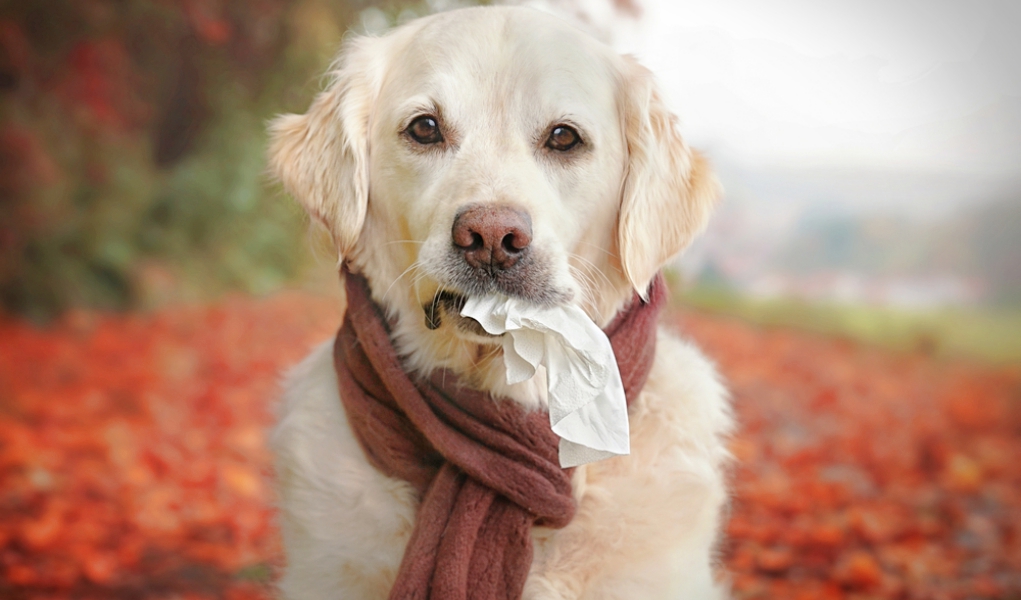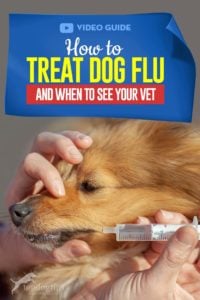Dog flu, also known as canine influenza or CIV, can become quite serious if it's not treated properly. It is a highly contagious virus that can effect dogs and cats. All pet parents need to learn how to treat dog flu, just in case your dog contracts this disease.
As the old saying goes, “an ounce of prevention is worth a pound of cure.” It's important to keep your dog away from any other dogs or cats exhibiting signs of canine influenza. Also, he should not visit an environment where an infected pet has been recently.
If your dog does contract the disease, you must keep him quarantined in your home until all symptoms have cleared up. When he no longer shows symptoms, you'll need to wash all of his bedding and disinfect his toys and dishes.
According to the American Veterinary Medical Association, there are vaccines available for both H3N8 and H3N2 canine influenza. You'll need to consult your veterinarian for information about these vaccinations and whether or not they are a good option for your pooch.
How to Treat Dog Flu
and when to see your vet
 Because canine influenza is caused by a virus, it can't be treated with antibiotics. When learning how to treat dog flu, all you can do is keep your pet comfortable, fed and hydrated. There is nothing that you can do to cure the flu. You just have to let it run its course naturally.
Because canine influenza is caused by a virus, it can't be treated with antibiotics. When learning how to treat dog flu, all you can do is keep your pet comfortable, fed and hydrated. There is nothing that you can do to cure the flu. You just have to let it run its course naturally.
While curing the flu isn't a possibility, there are many simple things that you can do to treat it. Learning how to treat dog flu is not difficult. For starters, you'll need to make sure that you keep your pup warm. You can do this by ensuring he has a comfortable dog bed to rest on and adding a blanket or bed heater if needed.
You also need to keep your dog dry. If he needs to go outside in rain or snow, outfit him with a dog jacket and/or booties. If your dog doesn't have outdoor clothing, just be sure to dry him off thoroughly when he comes in from outside (including his paws).
 While your dog is likely to be a bit lethargic when he's not feeling well, you will also want to try to limit his activity during this time. You can use a humidifier to help clear congestion and allow your dog to breathe easier.
While your dog is likely to be a bit lethargic when he's not feeling well, you will also want to try to limit his activity during this time. You can use a humidifier to help clear congestion and allow your dog to breathe easier.
Respiratory infections are one of the biggest worries for dogs that have contracted the flu. These infections can lead to pneumonia, especially in brachycephalic breeds (scrunchy nose dogs). If you notice that your dog is having trouble breathing or begins wheezing, you need to seek veterinary help immediately.
You may notice some eye and nose discharge. A small amount of discharge is normal. When learning how to treat a dog with a cold, you'll want to wipe any discharge when you notice it. Keeping his eyes and nose clear will ensure your dog is able to see and breathe without any trouble.
Speaking of Fido's nose, it may become dry if he's not feeling 100%. You can use a balm to prevent cracking and splitting. Adding honey and/or coconut oil to your pet's meals can also help skin and coat health. Honey and coconut oil also have natural anti-bacterial, anti-viral and immune boosting properties.
You'll need to monitor your dog's temperature closely when learning how to treat dog flu. I've created a video guide to show you how to take your dog's temperature. One of the biggest risks of canine influenza is a high fever.
 A dog's regular temperature averages about 100˚F-102.5˚F. That's a little warmer than the average human temperature of 98.6˚F. If your dog is running a slight fever, don't worry. You do not need to seek veterinary care unless your dog's temperature climbs above 104˚F.
A dog's regular temperature averages about 100˚F-102.5˚F. That's a little warmer than the average human temperature of 98.6˚F. If your dog is running a slight fever, don't worry. You do not need to seek veterinary care unless your dog's temperature climbs above 104˚F.
Your dog needs to eat and drink when he's not feeling well. A lot of dogs lose their appetite when they have the flu, but you've got to get him to consume something. Sometimes offering a diet of boiled chicken with rice will entice a dog to eat. You can also add low-sodium broth to his water bowl to entice him to drink.
It's crucial that your dog eats a little something to keep up his strength. If he doesn't stay hydrated, more serious health issues will crop up. If you can't get him to eat, there isn't much you can do to force him. However, if he won't drink you will have to force feed water with a syringe.
You cannot let your dog get dehydrated. As long as he is drinking a couple of ounces of water per hour, he'll be okay. If he won't drink on his own, be sure to give him at least 2 ounces of water per hour with a syringe.
 If your dog's flu symptoms last longer than 10-14 days or the symptoms begin to get worse, you should seek veterinary care. Also, you should NEVER give your dog human medication without consulting your veterinarian first. Some human medications are toxic to dogs, and even safe medications need to be dosed properly.
If your dog's flu symptoms last longer than 10-14 days or the symptoms begin to get worse, you should seek veterinary care. Also, you should NEVER give your dog human medication without consulting your veterinarian first. Some human medications are toxic to dogs, and even safe medications need to be dosed properly.
When learning how to treat dog flu, don't panic. I know it's sad to see your dog not feeling well, but the flu isn't anything to stress out about. It should run its course on its own, and you can use the tips above to keep your pet comfortable until he's feeling better.
READ NEXT: Dog Flu Symptoms and 6 Ways To Prevent and Treat It












